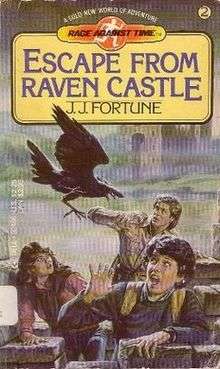Escape from Raven Castle
Escape from Raven Castle is book 2 of the Race Against Time series written by J. J. Fortune.
 First edition (US) | |
| Author | J. J. Fortune |
|---|---|
| Illustrator | Bill Sienkiewicz (map by Giorgetta Bell McRee) |
| Country | United States |
| Language | English |
| Series | Race Against Time series |
| Genre | Juvenile |
| Publisher | Dell Publishing (US) Armada (UK) |
Publication date | 1984 |
| Media type | Print (Paperback) |
| Pages | 140 pp |
| ISBN | 0-440-92406-5 |
| OCLC | 10399238 |
| Preceded by | Revenge in the Silent Tomb |
| Followed by | Evil in Paradise |
Plot summary
The book opened at a Saturday, 5:03 p.m., with a New York teen Stephen Lane, and his uncle Richard Duffy, being ambushed by hoodlums on a train stopping at a remote region in Scotland. The struggle ended with Stephen being kidnapped by two men who drove off in a black car while Richard was unable to follow as the train had started and was passing over a bridge.
This was followed by a flashback to the day before which saw Stephen's father and mother going off on a junket to San Francisco at the invitation of Fell Industries, leaving Stephen in their New York home under the charge of Richard.
The uncle-nephew were tossing ideas back and forth on how to spend the weekend when Richard received an emergency call from his old friend, Hamish Claymore, a retired British Intelligence officer, asking him to meet at Carrabash train station at 5:15 p.m. the following evening. Richard owed Hamish a favour from the past. The uncle-nephew duo found themselves flying Glasgow, after Richard called in a favour from another old friend, Lou.
After being abducted at the train station, Stephen was brought to a lone medieval fortress known as Raven Castle, which overlooked Killy Bay and the North Sea. Killy Bay, Raven Castle and Carrabash are fictional places created for the book.
In the castle, Stephen was brought before the main villain of the story, Jonathan Fell. Fell was an arms dealer who got his start in the business when as an officer during World War II, he misappropriated captured stocks of German weapons. He arranged the kidnapping of Stephen to force Richard Duffy to perform a mission.
Stephen managed to escape from the castle and ran into Richard who was given a lift by Annie MacKenzie, a marine biologist sent by a Royal Commission to investigate why all fauna and flora died in the local lake four decades before, and nothing could live in it, earning it the name Death Loch.
The trio soon found that though that Fell's gang of henchmen managed to cut off all routes in and out of this remote part of Scotland. The local town of Killy Bay had been at Fell's mercy for a long time.
Richard decided that the only way to come out tops was to infiltrate Raven Castle and capture Fell.
Non-recurring characters
- Jonathan Fell, death merchant whose ventures in the past had been thwarted by Richard.
- Annie MacKenzie, marine biologist.
- Hamish Claymore, retired British Intelligence officer.
Chapter headings
- Strangers on a train, Saturday: 5:03 P.M., Scotland
- Bored, bored, bored, Friday: 8:17 P.M., New York
- The Death Merchant, Saturday: 5:30 P.M., Scotland
- Locked in the tower, Saturday: 5:50 P.M., Scotland
- The Black Staircase, Saturday: 8:16 P.M., Scotland
- A getaway, Saturday: 8:28 P.M., Scotland
- “You take the high road …”, Saturday: 8:58 P.M., Scotland
- Torchlight Meeting, Saturday: 9:32 P.M., Scotland
- A Dangerous Game, Saturday: 10:50 P.M., Scotland
- Deep Waters, Saturday: 11:19 P.M., Scotland
- The Crack in the Castle Wall, Sunday: 12:26 A.M., Scotland
- “I’ll take the low road …”, Sunday: 1:33 A.M., Scotland
- High-pressure Diving, Sunday: 2:08 A.M., Scotland
- The Villain’s Tale, Sunday: 2:29 A.M., Scotland
- Death Dust!, Sunday: 2:54 A.M., Scotland
- Under the gun, Sunday: 3:09 A.M., Scotland
- Whose Heart is in the Highlands?, Sunday: 3:25 A.M., Scotland
- “and I’ll be hame afore ye”, Sunday: 12:02 A.M., New York